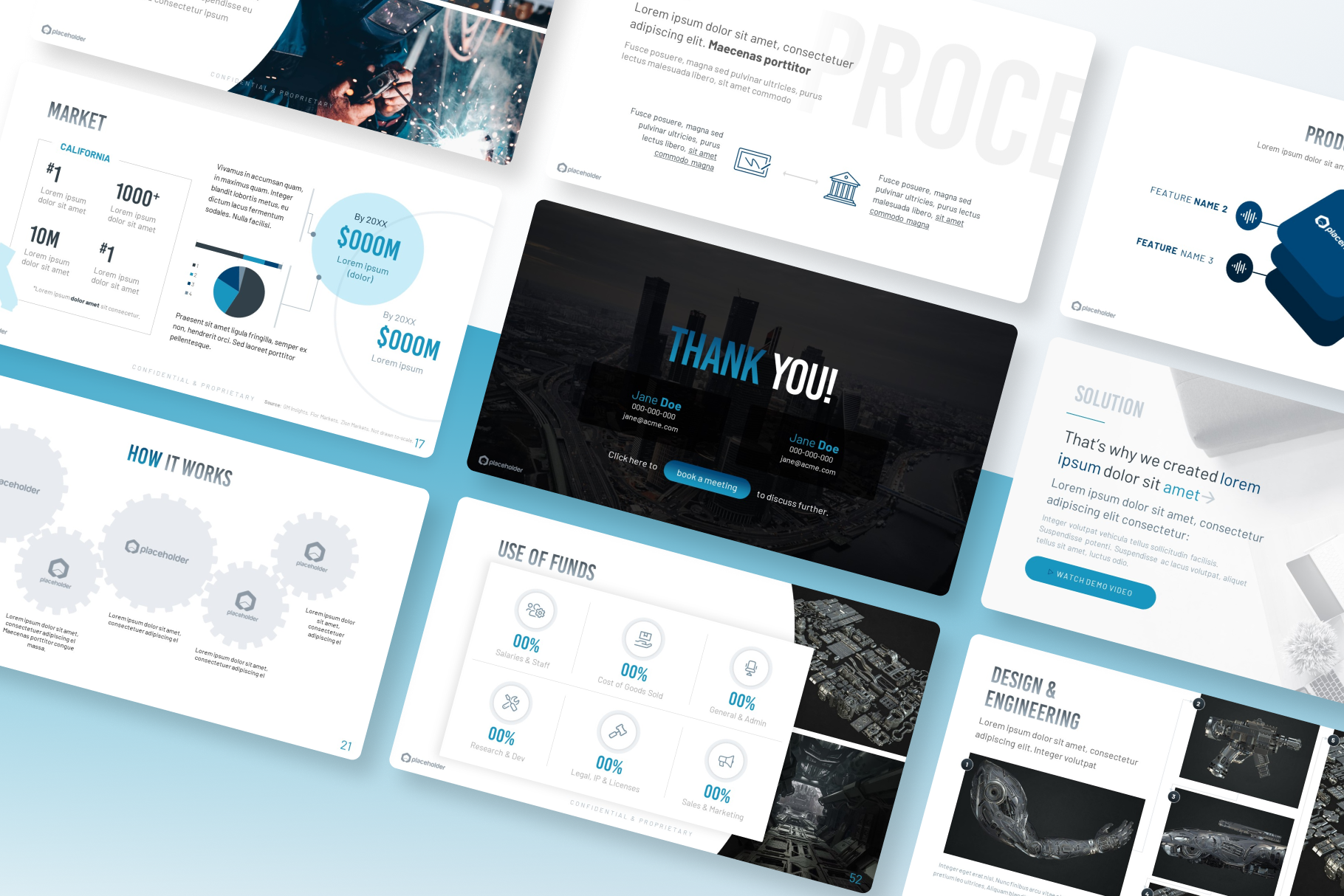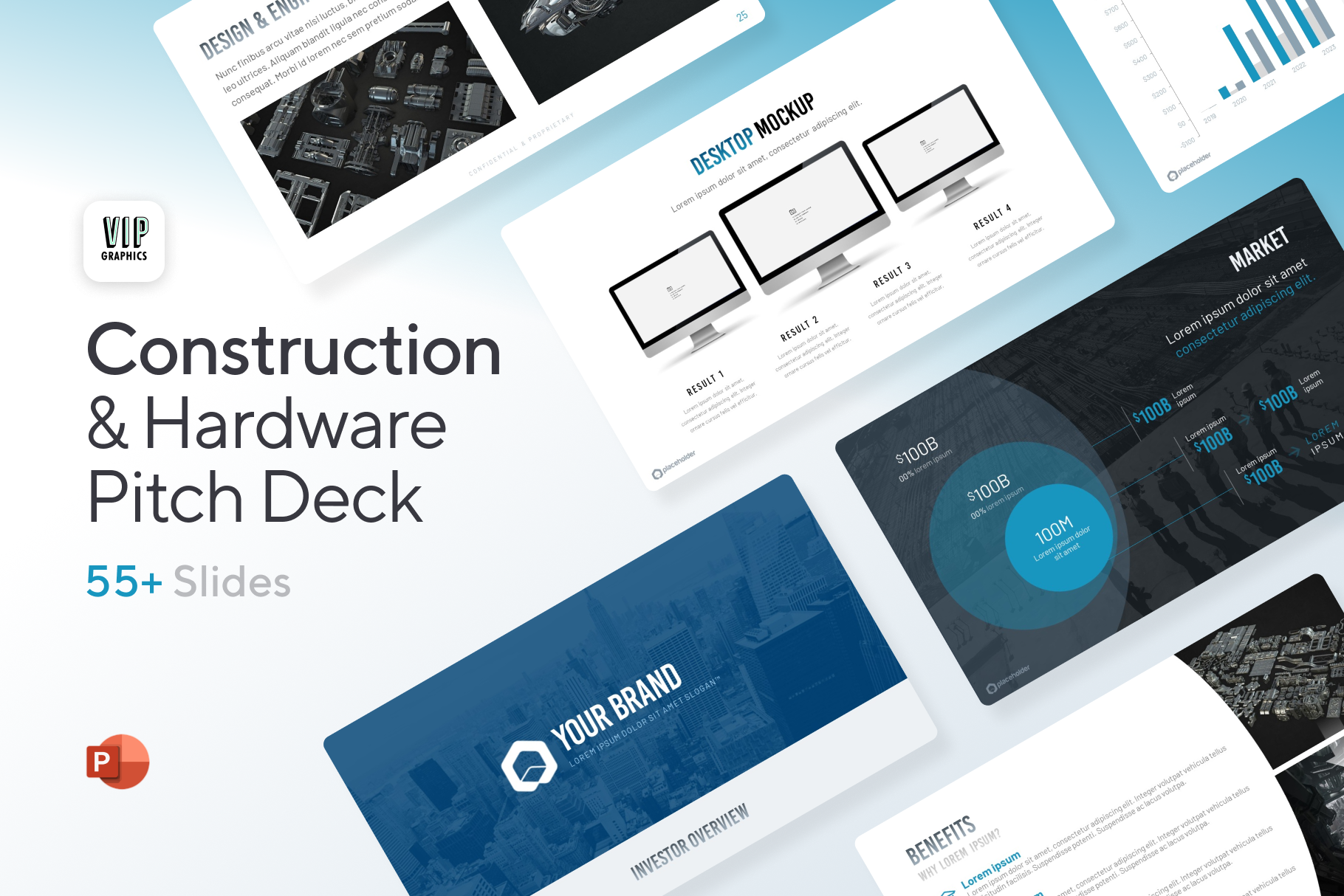The construction industry is undergoing a transformation, driven by technological advancements and shifting market demands.
Companies like Procore and Katerra have paved the way with cloud-based management tools and modular construction techniques, while innovative startups like Built Robotics are introducing automation to the job site.
For startups, however, raising capital in this traditional and competitive space remains a challenge.
A well-crafted pitch deck can be the key to standing out, helping startups communicate their value, showcase their market opportunity, and secure the funding needed to scale in this rapidly evolving industry.
What is a construction pitch deck? What is its purpose?
A construction pitch deck is a concise presentation that communicates your startup’s vision, product, and business opportunity to potential investors. It’s your chance to demonstrate how your innovation addresses key challenges in the construction industry and stands out as a lucrative investment opportunity.
The purpose of a construction pitch deck is to:
- Capture investor attention with a clear, compelling narrative.
- Showcase your product’s value proposition and unique approach.
- Highlight market opportunities, growth potential, and financial projections.
- Convince investors why your team is the right one to execute the vision.
The construction industry: challenges and opportunities
The construction industry is ripe for disruption. Facing significant labor shortages, outdated practices, and inefficiencies, the sector is primed for innovative solutions. Technology, particularly robotics and hardware, can revolutionize the execution of construction projects and increase efficiency, safety, and cost-effectiveness.
According to McKinsey, investment in construction technology is on the rise. Between 2014 and 2019, investors contributed $25 billion to engineering and construction (E&C) technology. That figure doubled to $50 billion from 2020 to 2022, underscoring the growing appetite for innovation in this space.
What slides should be in your construction startup pitch deck?
Each slide in your pitch deck should serve a distinct purpose and guide the narrative of your startup’s potential. Here’s what you should include:
Cover slide
The cover slide should present your startup’s logo, tagline, and a visually striking image that conveys your vision. Use a clean and professional design to set the tone for your pitch.
Tip: Include a relevant image, such as a construction site, robotic equipment, or workers using innovative tools, to instantly connect with your audience.
Problem slide
The problem slide should clearly define the pain points your startup addresses. For the construction industry, this might include labor shortages, inefficiencies, safety risks, or rising project costs.
For example, highlight a statistic like, “The U.S. construction industry faces a labor gap of 430,000 workers annually,” and explain how this impacts project timelines and costs.
Avoid being too broad. Focus on a specific issue your product or service solves.
Solution slide
The solution slide should showcase how your product or service solves the problems you previously outlined. Be specific about the outcomes it delivers, such as reducing costs or accelerating project timelines.
Tip: Use simple, jargon-free language that makes the solution easy to understand.
How it works slide
This slide should explain how your product functions using simple visuals like screenshots, photos, or mockups. Avoid technical jargon or architecture diagrams, focusing instead on usability and effectiveness.
For example, show a step-by-step process of how your construction robot scans a site, identifies tasks, and executes them.
Use real-world images or a short video demonstration if possible to make the process tangible.
Competitive advantage / differentiation slide
Your competitive advantage slide should highlight what sets your solution apart from others. This could be proprietary technology, significant cost savings, or faster implementation. Clearly articulate your moat against competition.
Include a comparison chart showing how your product performs better than competitors on key metrics.
Market / opportunity slide
The market slide should outline the size and potential of your target market. Be specific and focus on the segments your startup addresses. Use statistics to emphasize growth opportunities.
For example, “The global construction robotics market is projected to grow from $2 billion in 2022 to $10 billion by 2030.”
Tip: Break down your total addressable market (TAM) into smaller, actionable segments, such as high-rise developers or subcontractors.
Target market slide
The target market slide should explain the specific customer segments that will benefit from your solution. This could include contractors, construction firms, or developers. Include personas or case studies to make your target audience relatable.
Traction slide
The traction slide should showcase your progress, such as patents, early customer feedback, partnerships, or media coverage. Use this slide to prove your concept is gaining momentum.
For example, “signed partnerships with 5 major contractors, representing $1 million in annual recurring revenue.”
Highlight any pilot projects or beta testers to demonstrate early adoption.
Business model slide
The business model slide should explain how your startup generates revenue. Include details on pricing, revenue streams, and unit economics such as profit margins or LTV/CAC ratios. Make your revenue model simple and scalable.
Team slide
The team slide should highlight the expertise and experience of your team members. Showcase how their backgrounds align with your startup’s goals and industry needs.
Tip: Include advisors or board members with strong industry ties to boost credibility.
Investment slide
The investment slide should state the funding amount you’re seeking and how you’ll allocate it to achieve your milestones. Be transparent about how the investment will drive growth. Include a pie chart or bullet points to illustrate the allocation of funds.
Roadmap slide
The roadmap slide should outline your future milestones, including product launches, market expansion, and revenue goals. A clear timeline demonstrates your strategy for growth. Align your roadmap milestones with investor expectations for ROI.
Vision slide
The vision slide should articulate your long-term ambition for the startup. Focus on the transformative impact your solution will have on the construction industry.
Tip: Keep your vision aspirational yet grounded in your solution’s potential.
Call-to-action slide
The call-to-action slide should provide a clear next step, such as scheduling a meeting, requesting a demo, or contacting your team for more information. Include your contact information and a QR code linked to your website or demo video for easy access.
Examples of successful constructive pitch decks
Drawing inspiration from successful construction startups can help you craft a pitch deck that captures investor attention. Below are real-world examples of pitch decks from innovative construction startups that secured funding:
- VaiVolta is an online platform that helps construction companies rent and manage equipment and machinery efficiently. They raised $100K in 2014 with their pre-seed pitch deck, demonstrating the value of their SaaS platform tailored to the construction industry.
- Survmetrics provides software solutions for construction subcontractors to streamline workflows and enhance collaboration. They raised $100K in 2014 with a seed round pitch deck focused on their SaaS platform’s unique ability to simplify subcontractor operations.
- iControl is a cloud-based application designed to improve construction project management and facilitate collaboration among stakeholders. The company raised $150K in 2016 during its seed funding round by showcasing the SaaS platform’s capacity to reduce delays and miscommunications on job sites.
These examples illustrate how effective pitch decks can convey the value of a construction startup’s solution, highlight market potential, and secure early-stage funding.
Tips for designing a winning construction startup pitch deck
Creating a pitch deck that stands out to investors requires a strategic approach tailored to the construction industry. Here are some essential tips to keep in mind:
- Focus on benefits, not features, when comparing to competitors. Highlight how your product or service solves problems and delivers tangible value to your customers. Instead of emphasizing technical specifications, demonstrate how your solution improves efficiency, reduces costs, or addresses labor shortages.
- Be focused when presenting your market size. Avoid citing the entire construction industry as your target market. Narrow it down to specific segments that your product directly addresses, such as subcontractors, developers, or mid-sized contractors. Use data to back up your focus and demonstrate a clear path to market entry and growth.
Construction pitch deck template
Ready to get started? Use this Construction Pitch Deck template by VIP Graphics to streamline your design process and create a winning presentation. A well-designed pitch deck is your best tool for securing investor funding. By following this guide, you’ll be able to present a compelling case for your construction startup and stand out in a competitive market.

